
At the forefront of rhinoplasty, Dr. Robert Morin understands that the “perfect nose” is a matter of personal aesthetics and facial harmony. Each patient’s unique anatomy plays a crucial role in achieving balance; what looks ideal on one person may not suit another. Guided by principles like the Marquardt theory, Dr. Morin evaluates the proportional relationship between the nose and other facial features, ensuring that the result is not just beautiful but natural.
Rhinoplasty is Dr. Morin’s passion, and he utilizes advanced techniques, including Ultrasound Rhinoplasty, to enhance both the appearance and function of the nose. This innovative approach minimizes recovery time and bruising while allowing for precise corrections. Whether addressing cosmetic issues like a dorsal hump or functional concerns such as a deviated septum, Dr. Morin’s expertise ensures that your results match your unique profile, enhancing your confidence and self-image.
Transform your appearance with a nose that complements your facial features. Experience the difference with Dr. Morin’s compassionate care and skill—schedule your consultation for a nose job in New Jersey today!
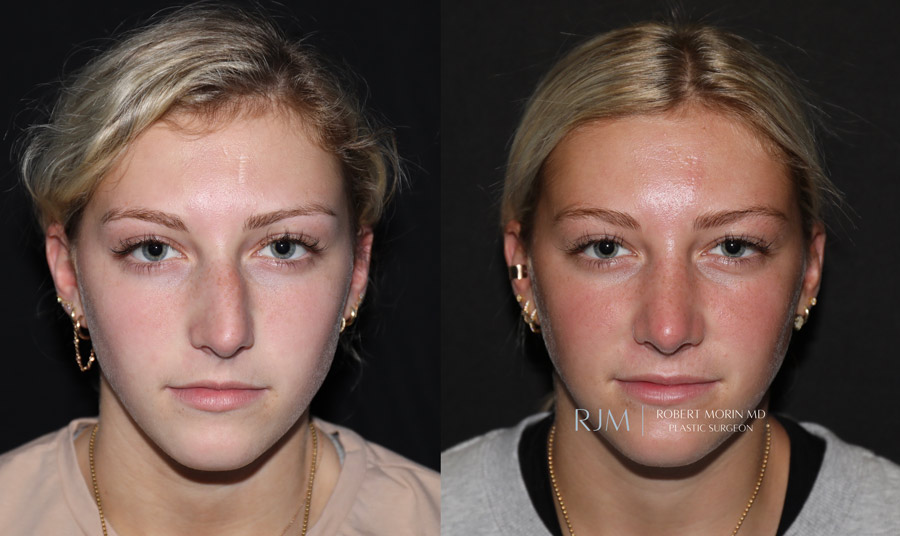
*Results may vary

Actual rhinoplasty patient
Rhinoplasty is a versatile procedure that addresses a wide range of aesthetic and functional concerns related to the nose. It’s so popular that nearly 45,000 rhinoplasties were performed in the United States in 2022, making it the third most common facial plastic surgery, following eyelid and facelift surgeries. Many individuals seek rhinoplasty not only to enhance their appearance but also to improve their quality of life. This surgery can correct various issues, leading to greater facial harmony and improved breathing. Here are some common concerns that rhinoplasty can effectively address:
Patients often come to Dr. Morin to correct visible deviations in their noses, which can disrupt facial symmetry. A crooked nose may be the result of genetics or previous trauma. By realigning the nasal structure, rhinoplasty can restore balance and enhance the overall aesthetic appeal of the face.
A dorsal hump, or a prominent bump on the bridge of the nose, can detract from an otherwise smooth profile. Patients seeking to reduce this bump often desire a more refined side view. Rhinoplasty can sculpt the nasal bridge, creating a more aesthetically pleasing contour and achieving a harmonious facial profile.
A drooping nasal tip can create an aged appearance, affecting how the rest of the face is perceived. By elevating the tip during rhinoplasty, patients can achieve a more youthful and rejuvenated look. This adjustment not only enhances facial aesthetics but also contributes to improved confidence.
For many, rhinoplasty is not just about cosmetic enhancement; it also serves a functional purpose. Issues such as nasal obstruction due to structural abnormalities can hinder airflow, impacting quality of life. Functional rhinoplasty addresses these problems, correcting anatomical issues like a deviated septum and promoting better breathing.
Dr. Morin’s rhinoplasty approach combines comprehensive surgical expertise with personalized care, ensuring each patient’s aesthetic and functional needs are met. His background as a board-certified plastic and craniofacial surgeon allows him to address both complex reconstructive and cosmetic concerns, achieving natural, balanced results.
Dr. Robert Morin’s rhinoplasty process begins with understanding each patient’s unique facial structure and aesthetic goals. His extensive training in craniofacial and pediatric plastic surgery provides him with a deep understanding of facial anatomy, enabling him to craft a plan unique to each individual’s needs. His consultations are thorough and unhurried, ensuring every patient feels heard and confident in the surgical plan. Dr. Morin’s approach combines empathy and skill, focusing on delivering results that enhance facial harmony without sacrificing functionality.
A pioneer in complex rhinoplasty cases, Dr. Morin employs specialized techniques such as ultrasound rhinoplasty, which allows for precise nasal bone sculpting without the trauma of traditional methods. He chooses between open and closed rhinoplasty based on each patient’s anatomy and desired outcome, aiming to minimize scarring while achieving natural results. His advanced approach is particularly beneficial for challenging or revision cases, where precision and innovation are critical for success and patient satisfaction.
Dr. Morin’s commitment to patient care extends beyond the operating room. He provides comprehensive post-operative support, including personalized recovery instructions to facilitate healing and optimize results. Regular follow-ups ensure patients are supported throughout their rhinoplsty recovery and address any concerns promptly. Dr. Morin’s compassionate approach and thorough post-operative care reinforce his dedication to achieving the best possible outcomes and a smooth, comfortable recovery experience for each patient.
What makes Dr. Morin different? Read a few of Dr. Morin’s reviews and you’ll start to understand how he stands apart from other rhinoplasty surgeons in New Jersey.
READ REVIEWSWith a distinguished career in rhinoplasty, Dr. Morin has built a reputation for his surgical expertise. He has been invited to lecture at prestigious institutions such as Lenox Hill Hospital and Rutgers University, further solidifying his standing in the field. This level of expertise allows Dr. Morin to craft highly personalized surgical plans that align perfectly with each patient’s unique goals.
Dr. Morin’s consultation involves a detailed discussion of your nasal anatomy, goals, and any functional concerns, such as breathing difficulties. He’ll guide you through surgical options, explaining the steps and outcomes to help you feel fully informed. Dr. Morin believes that it is vital that patients grasp the steps of the procedure, as well as understand what is possible. During your pre-surgery consultation, he will encourage you to refer to photos and ask questions. In addition to the conversational preparation with Dr. Morin, there are some basic medical recommendations to follow prior to a rhinoplasty such as avoiding smoking as well as medications such as Aspirin and Ibuprofen.
Before surgery, Dr. Morin provides guidelines to ensure optimal healing. This may include medication adjustments, fasting requirements, and lifestyle tips to support a smooth recovery. Detailed instructions help you prepare both physically and mentally.
Dr. Morin’s team assists out-of-town patients with accommodations and travel in New Jersey, ensuring a smooth, well-coordinated visit. The office provides guidance and recommendations for comfort, letting you focus on recovery.
You’ll review final pre-surgery instructions, including fasting or self-care steps, to optimize readiness. These simple preparations, guided by Dr. Morin’s team, ensure you’re relaxed and fully prepared for surgery.
On the day, Dr. Morin’s staff welcomes you, ensuring all steps are carefully followed. After general anesthesia is administered, Dr. Morin performs the procedure, using techniques like open or closed rhinoplasty, based on your unique needs. To guide the procedure, Dr. Morin may use the Marquardt Mask, a visual aid that helps evaluate how your nose complements the rest of your facial features, ensuring optimal harmony between the nasal bridge and tip.
Follow-up care involves scheduled visits to track your recovery, with Dr. Morin addressing any questions or concerns. You’ll receive detailed instructions for a safe, effective healing process, ensuring you’re supported at every stage.
Traveling patients receive personalized guidance on post-surgery travel and safety precautions for their return. Dr. Morin’s office helps coordinate travel logistics, supporting a safe transition after rhinoplasty recovery in New Jersey.
It will take 2-3 weeks to be able to return to social engagements. Dr. Morin will place a splint over the operated nose. Think of this as a bandage that is helping to hold the aspects of the new nose together. The splint is usually removed at Dr. Morin’s office after one week. It is normal to experience swelling and bruising during the initial stages of recovery. Lastly, if you are experiencing pain at any point during your recovery, NJ rhinoplasty specialist Dr. Morin may prescribe pain medication to ease the process and to maximize your comfort.
Ready to start looking your best? We offer virtual and in-office consultations.
Once the patient is asleep, Dr. Morin will make incisions so that he can gently lift the skin and access the underlying tissues of bone and cartilage, which he will resculpt. Incisions can be made either inside the nose or they can be made both inside the nose and on the of skin that separates the nostrils, or the columella. The former technique is known as a closed rhinoplasty and the latter is called an open rhinoplasty. There are advantages and disadvantages to both the closed and open rhinoplasties and Dr. Morin will use the technique best suited to the individual patient. Incisions made on the columella generally usually heal well, resulting in a barely perceptible external scar after an open rhinoplasty.
“I was looking for a more conservative approach. Yet, all of the doctors I met with seemed to want to push me to go even further, or seemed to want to conduct the rhinoplasty in a way that matched a style that they’d gotten used to”
“Unlike many doctors I have had in the past, Dr. Morin seemed to take my well-being as number one priority and that made me feel confident and safe.”
“I interviewed, researched and met with other top surgeons in Hackensack, but no one met my high expectations until I met Dr. Morin“
Dr. Morin is dedicated to helping you achieve your aesthetic goals.
Candidates for rhinoplasty are typically individuals seeking to enhance their nose’s appearance or improve nasal function. Ideal candidates are in good health, have realistic expectations, and are at least 16 years old, ensuring facial growth is complete. To see real patient results and learn more about the process, we encourage you to read our case studies.
Read Case Studies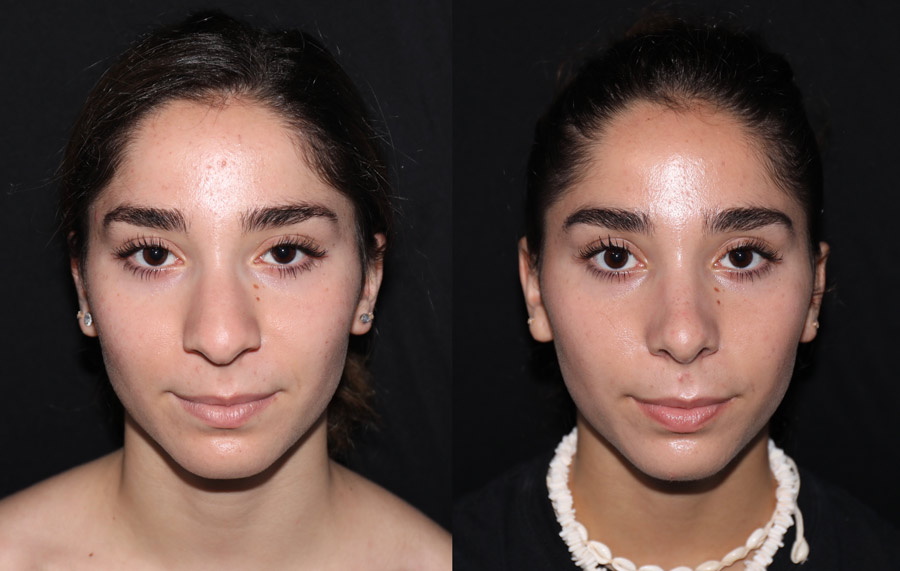
*Results may vary
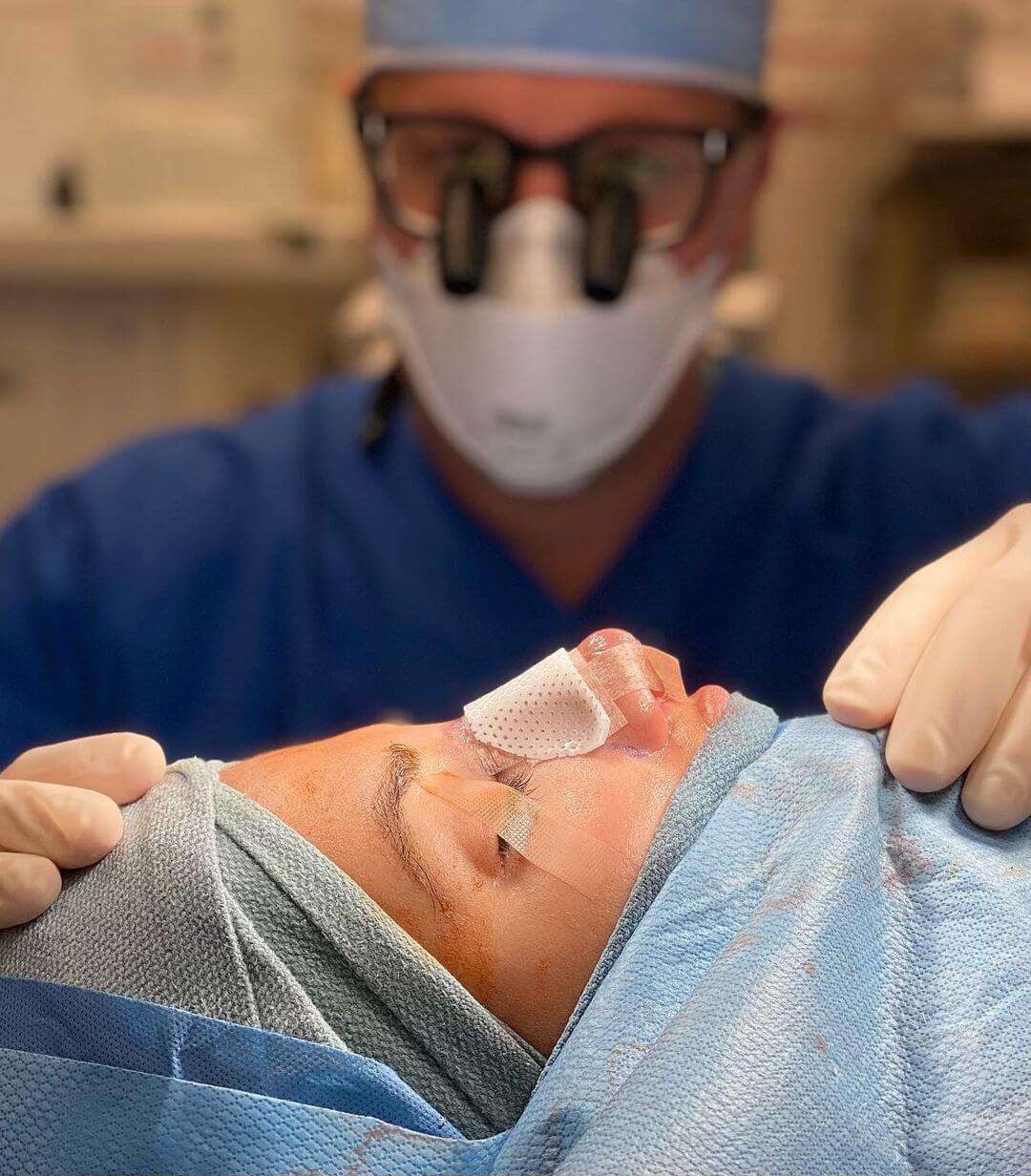
Another factor to consider in describing the perfect nose is gender. Certain features can make a face appear more masculine or feminine. For instance, the shape of the face, the density of the eyebrows, and the contour of the cheekbones all influence whether we see a face as male or female.
The male nose is often characterized by angular, sharp edges and straight lines. These angles give a chiseled appearance, complementing other facial angles (a strong jaw bone, for example).
Unlike the strong, angular traits associated with the male nose, the female nose tends to be less striking. On a female face, the objective would be to downplay the visual prominence of the nose. By minimizing the definition and depth of the bridge of the nose, for instance, less emphasis is placed on the nose. Instead, attention is drawn to the lips and eyes. Balancing the details of the nostril shape and the tip also contributes to a more feminine appearance of the nose.
Though risks and complications are relatively rare, they do exist. Dr. Morin, a specialist in cosmetic surgery of the head and face, combines his extensive experience and meticulous approach to minimize risks and ensure the best possible outcomes for his patients. He wants your surgery to go as smoothly as possible, from start to finish. It is for this reason that he always stresses that his patients disclose all medical and personal information that may be relevant before committing to surgery. The most common risks and complications associated with a rhinoplasty include:
Again, these risks are rare but they must be considered when deciding whether or not to go forth with your potentially life-changing decision.
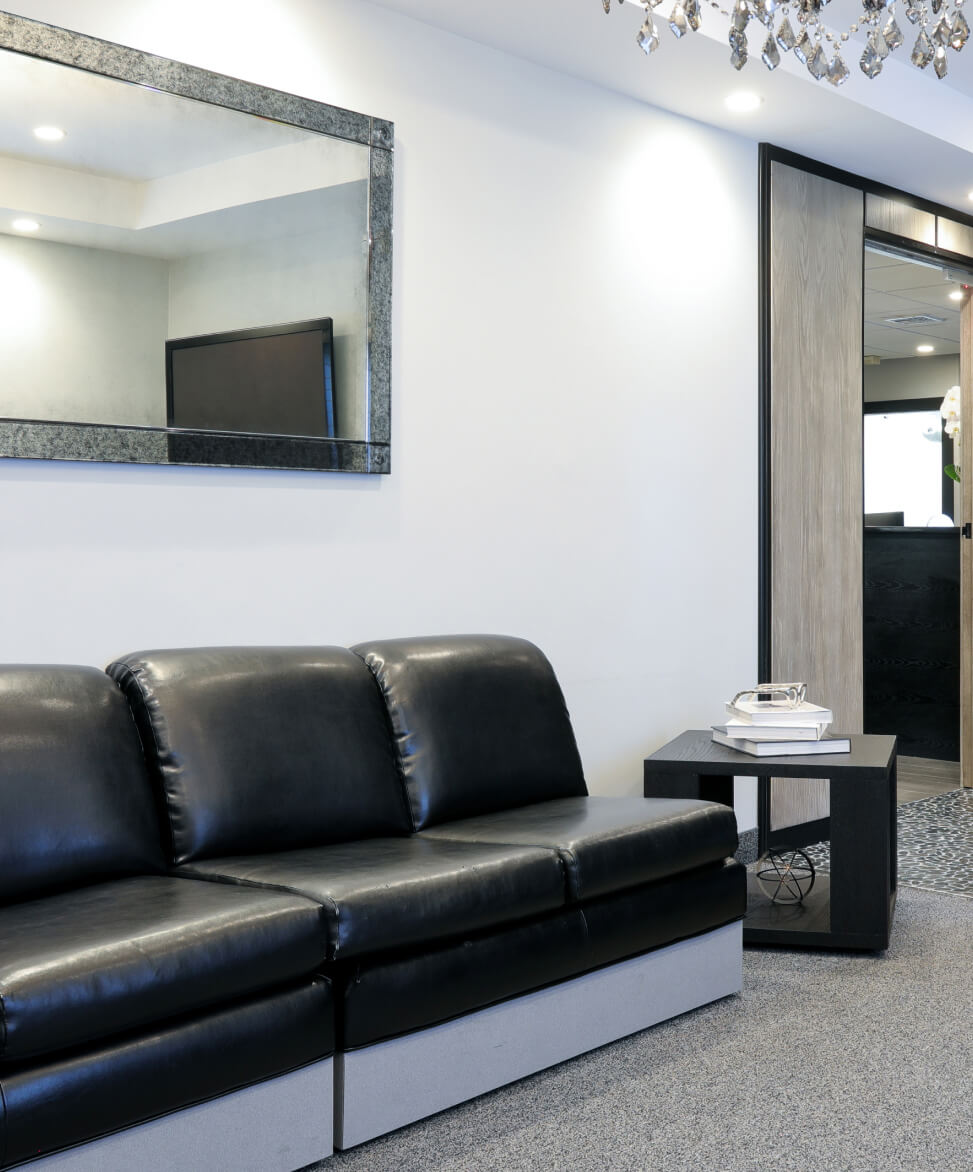
During rhinoplasty recovery, Dr. Morin prioritizes reducing swelling and bruising, advising patients to follow several best practices. Initially, sleeping with an elevated head helps manage swelling, as does avoiding heavy lifting and physical activity for at least three weeks. He suggests eating soft foods to minimize strain on facial muscles, refraining from smoking and alcohol to avoid exacerbating swelling and avoiding sun exposure for better healing. Swelling lessens within the first two months, although final results can take up to a year to fully settle. For additional comfort, pain medication may be prescribed as needed.
A rhinoplasty with septal cartilage grafting was performed on this 29 year old woman who was concerned about her large bulbous tip, wide nasal bones and irregular nasal dorsum. Her small irregular dorsal hump was removed, her nasal bones were narrowed and her tip was refined in order to create a smaller, more defined and more beautiful nose.
View Gallery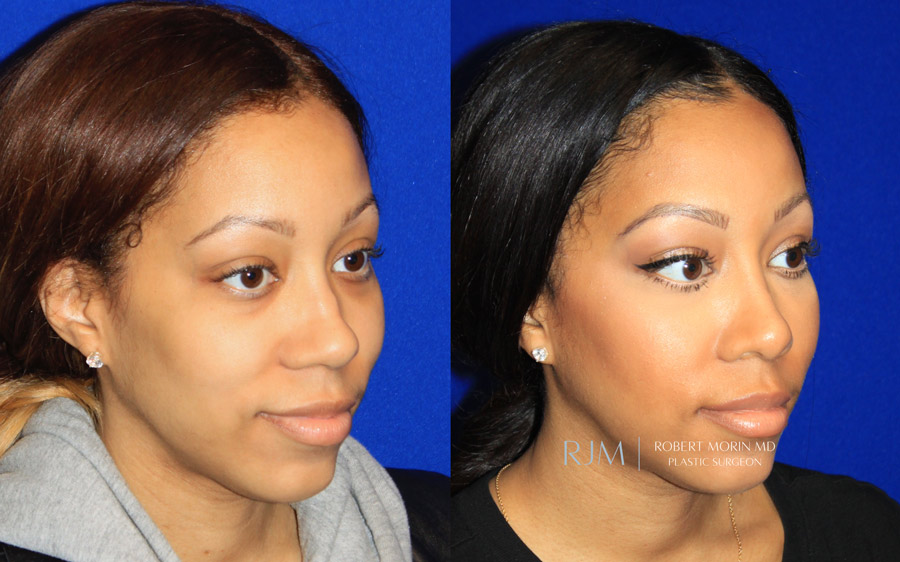
*Results may vary
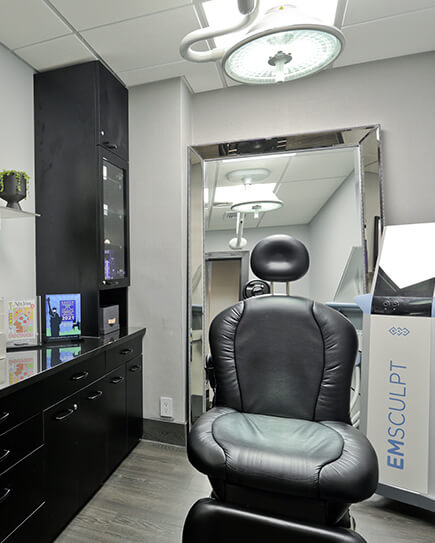
Dr. Robert Morin, MD, FACS, is renowned for his expertise in complex rhinoplasty. His work has earned him numerous awards and international acclaim, and he’s known for exceptional patient care, reflected in his top rating for New Jersey. For natural-looking results, contact Dr. Morin, one of the top rhinoplasty doctors in NJ, to discuss your goals and options.
Contact us today to schedule your consultation!
Enhance your features with our related offerings.
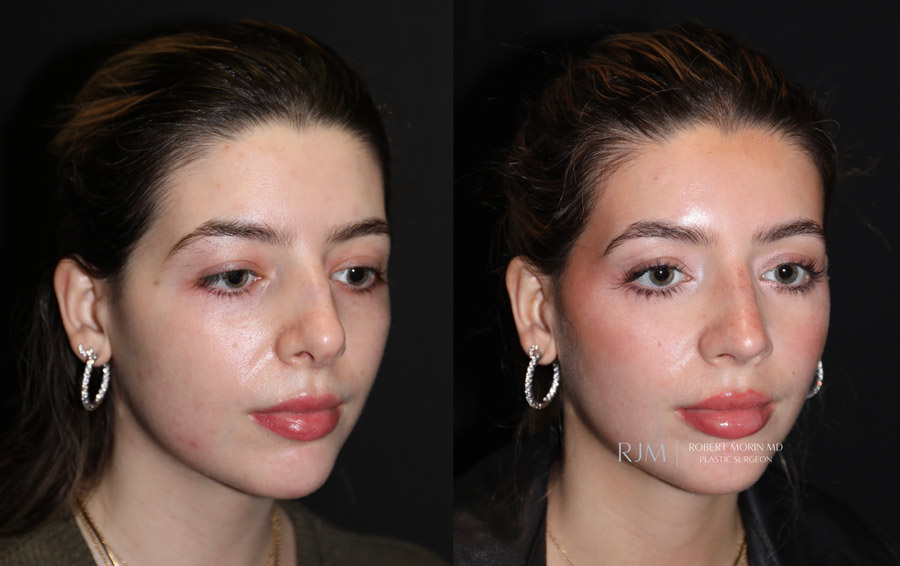
*Results may vary
During rhinoplasty, the surgeon can access the underlying nasal framework in two ways – through the nostrils (a closed rhinoplasty) or by separating the nasal skin from the underlying structures (an open rhinoplasty). Neither method in itself is superior, but some doctors have a preference for an open or closed rhinoplasty approach. In most cases, when major changes are being made, an open rhinoplasty provides the doctor with better access to the nasal structures and a clearer view.
There is no risk of scarring associated with a closed rhinoplasty. In an open rhinoplasty, a tiny incision is made across the columella, the strip of skin that separates the two nostrils. In most cases, the scar left from this incision is barely visible to the naked eye, especially when a skilled surgeon performs the procedure.
Yes. It is quite common for a plastic surgeon to correct problems in the underlying nasal framework to restore proper nasal function. In some cases, a problem in the nasal structure is responsible for both a physical and functional defect.
Rhinoplasty can be performed on teenagers after their noses have reached full adult size. This usually occurs around the age of 16 in females and around 18 in males. It is also important that the patient is emotionally mature enough to handle the demands of the surgery and recovery period.
Ethnic rhinoplasty refers to a rhinoplasty performed on people of non-Caucasian descent. Surgeons who perform ethnic rhinoplasty must take the patient’s unique heritage into account to shape a nose that looks natural on their face. Not all surgeons can perform ethnic rhinoplasty, so it is important to find a surgeon who is experienced in performing rhinoplasty in patients who are similar to you.
The starting cost for a rhinoplasty with Dr. Morin is $13,500, which includes the surgeon’s fee, anesthesia, and surgical facility expenses. During the consultation, Dr. Morin will review your unique needs to provide an accurate estimate, as costs vary based on case complexity, surgical techniques, and whether it’s a revision procedure.
Typically, insurance doesn’t cover rhinoplasty, as it’s considered cosmetic. However, if it addresses a functional issue, like a deviated septum or trauma-related obstruction, insurance might cover part of the procedure. Dr. Morin’s team can help you explore these options.
Look for a board-certified surgeon with extensive rhinoplasty experience. Dr. Morin, a member of the Rhinoplasty Society, combines years of experience with a personalized approach to achieve natural results. Checking before-and-after photos and scheduling consultations are also essential steps.



Dr. Robert J. Morin is a board-certified plastic surgeon with expert expertise in rhinoplasty. His extensive training, precise understanding of the intricacies of nasal anatomy, and commitment to personalized patient care help create a more harmonious and natural facial profile. Serving Hackensack, NJ, Dr. Morin specializes in both functional and cosmetic rhinoplasty, as well as a full spectrum of plastic surgery solutions for both pediatric and adult patients.




Ready to start looking your best? We offer virtual and in-office consultations.